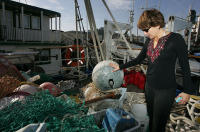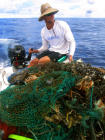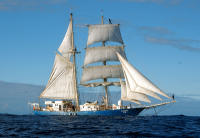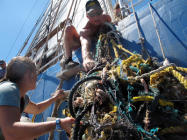Richmond-based ship search for ways to clean up offshore garbage patch
By Mike Taugher
Contra Costa Times
Posted: 11/29/2010 02:39:31 PM PST
Updated: 11/30/2010 08:46:15 AM PST
Juanita Oros, a project manager and medic for the Kaisei expedition, shows plastic trash...




It might be easier to clean up if the lawn chairs, water bottles and fishing nets all clumped together like a giant island of trash.
But the Great Pacific Garbage Patch is more scattered, which makes things challenging for the crew of a Richmond-based ship trying to find ways to clean up the mess.
"When you are out there you expect to see a sign: 'Welcome to the Gyre,'" said Nicholas Mallos, a marine debris scientist who sought to dispel popular notions of what the garbage patch is.
"It's not a floating island of trash. It's not the size of Texas," said Mallos, who works for the environmental group Ocean Conservancy. Though not always as obvious as a 3-ton "ghost net" or a floating mass of garbage -- which are out there, here and there -- the garbage collecting in the oceans is a serious global problem.
The trash, mostly plastics, collects in a vast region in the middle of the Pacific where four currents create a gyre, or vast vortex. Containers, nets and tiny bits of plastic are all swirling about, hundreds of miles offshore.
The crew of the Kaisei, a 151-foot brigantine tall ship that spends about half its time docked in Richmond, sailed for a few weeks in August in the garbage patch, also known as the North Pacific Gyre. It was the second voyage for Project Kaisei, which has a goal of eventually cleaning up the trash.
Speaking to reporters and others after their latest voyage this month, Mallos and Project Kaisei co-founder Mary Crowley described what they saw and their plans to try to clean up the garbage.
The trip confirmed that computer models are accurately predicting where the garbage is so that cleanup barges and ships can more effectively conduct large-scale trash removal.
In the few weeks the Kaisei was in the gyre, the crew collected thousands of pieces of plastic garbage and saw tiny bits of plastic entering the food web through small marine animals.
They picked up lids, containers, toothbrushes and car fenders.
Mallos said the problem is not readily apparent until one gets 500 miles off the coast of California, where tiny bits of plastic shimmer near the water's surface. The concentrations are heavier about 1,200 to 1,500 miles offshore, halfway to Hawaii, with discarded, rolled up fishing nets, sometimes adorned with other trash and trapped wildlife.
Crowley said the garbage extends to about 500 miles off the coast of Asia.
But the garbage still is not a massive island. It is more like an archipelago, Mallos said.
The plastics have been accumulating for decades and are extremely slow to degrade, though they do break into smaller bits that can be mistaken for food by small animals.
The trash mostly comes from shores both east and west but is also discarded by ships. In the gyre are lawn chairs that may have been left on a beach somewhere, containers washed from a road or tossed into a creek. And it has come from California, Asia and other regions along the Pacific's coasts.
Next year, Crowley and her partners plan to test ways to safely remove plastic trash off the coasts of San Diego and Seattle.
Then, they hope to take barges out to the garbage patch and see how well they work.
"Five, six, seven, eight years from now, everybody is going to feel the extent of the problem because it's going to be on the beaches," Crowley said.
They have a large floating "beach" design they hope can pick up bits of plastic without scooping up plankton, and they are planning to try methods used in the Deepwater Horizon oil spill cleanup.
"There is a sense that a lot of things that worked for oil spills could work for plastic," Crowley said," because, in effect, this terrible proliferation of plastic is just another form of oil spill."
Mike Taugher covers the environment. Contact him at 925-943-8257.



